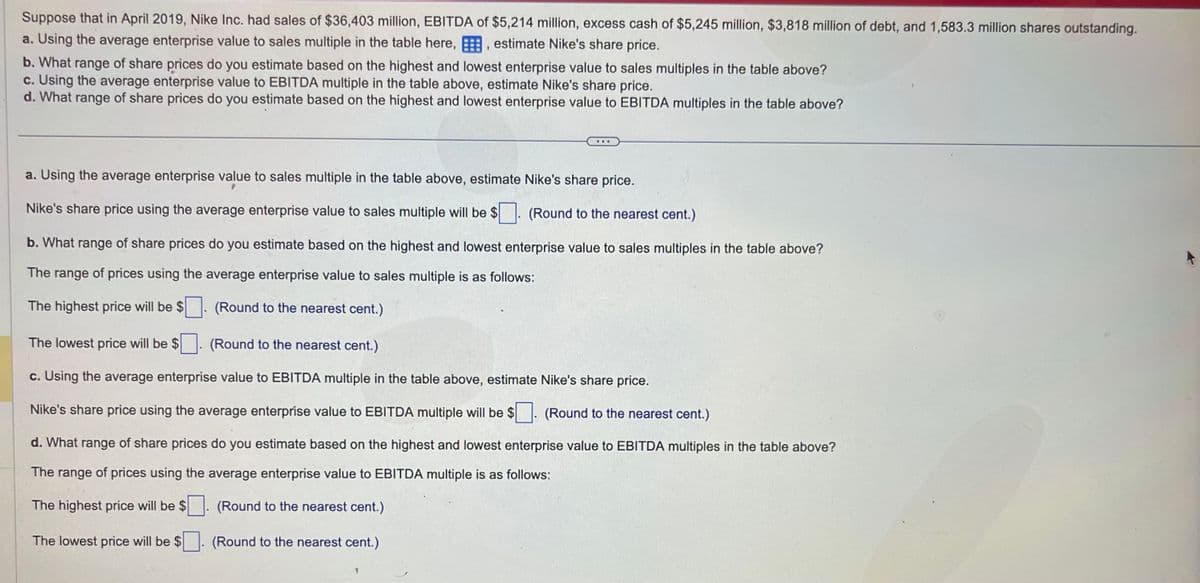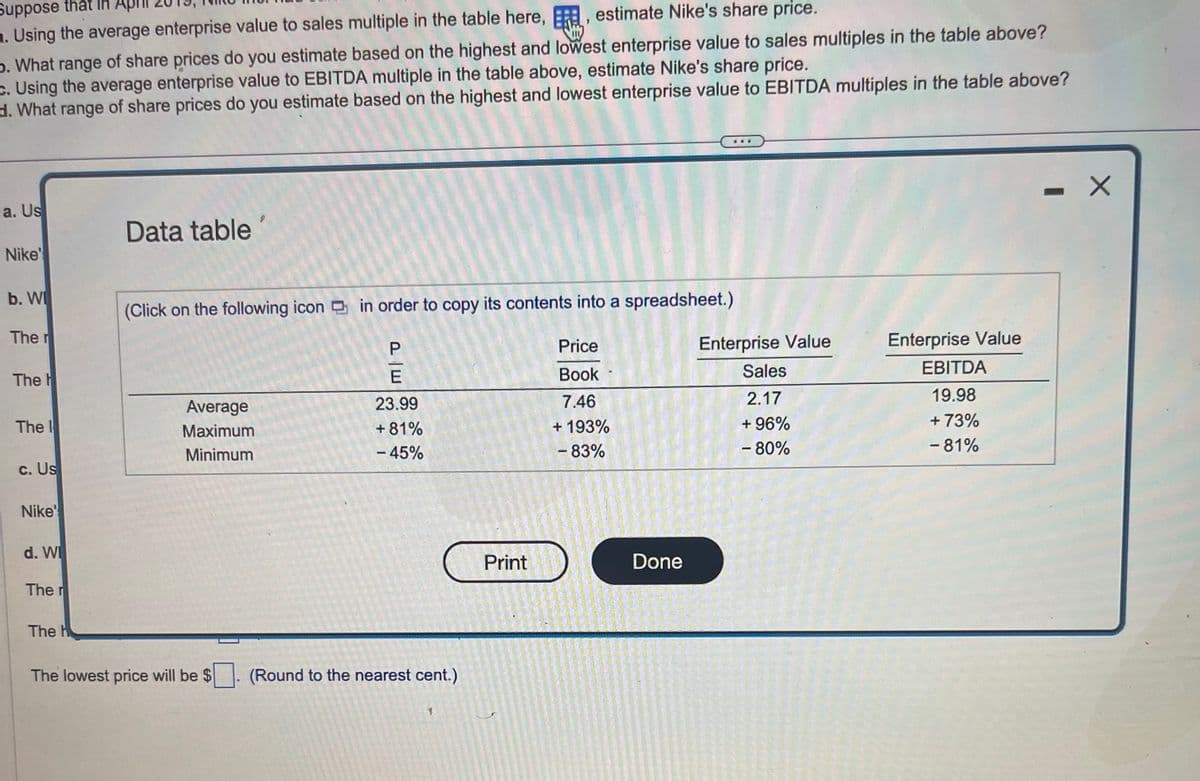Suppose that in April 2019, Nike Inc. had sales of $36,403 million, EBITDA of $5,214 million, excess cash of $5,245 million, $3,818 million of debt, and 1,583.3 million shares outstanding. a. Using the average enterprise value to sales multiple in the table here,, estimate Nike's share price. b. What range of share prices do you estimate based on the highest and lowest enterprise value to sales multiples in the table above? c. Using the average enterprise value to EBITDA multiple in the table above, estimate Nike's share price. d. What range of share prices do you estimate based on the highest and lowest enterprise value to EBITDA multiples in the table above? a. Using the average enterprise value to sales multiple in the table above, estimate Nike's share price. Nike's share price using the average enterprise value to sales multiple will be $. (Round to the nearest cent.) b. What range of share prices do you estimate based on the highest and lowest enterprise value to sales multiples in the table above? The range of prices using the average enterprise value to sales multiple is as follows: The highest price will be $ (Round to the nearest cent.) The lowest price will be $ (Round to the nearest cent.) c. Using the average enterprise value to EBITDA multiple in the table above, estimate Nike's share price. Nike's share price using the average enterprise value to EBITDA multiple l be $ (Round to the nearest cent.) d. What range of share prices do you estimate based on the highest and lowest enterprise value to EBITDA multiples in the table above? The range of prices using the average enterprise value to EBITDA multiple is as follows: The highest price will be $. (Round to the nearest cent.) The lowest price will be $. (Round to the nearest cent.)
Suppose that in April 2019, Nike Inc. had sales of $36,403 million, EBITDA of $5,214 million, excess cash of $5,245 million, $3,818 million of debt, and 1,583.3 million shares outstanding. a. Using the average enterprise value to sales multiple in the table here,, estimate Nike's share price. b. What range of share prices do you estimate based on the highest and lowest enterprise value to sales multiples in the table above? c. Using the average enterprise value to EBITDA multiple in the table above, estimate Nike's share price. d. What range of share prices do you estimate based on the highest and lowest enterprise value to EBITDA multiples in the table above? a. Using the average enterprise value to sales multiple in the table above, estimate Nike's share price. Nike's share price using the average enterprise value to sales multiple will be $. (Round to the nearest cent.) b. What range of share prices do you estimate based on the highest and lowest enterprise value to sales multiples in the table above? The range of prices using the average enterprise value to sales multiple is as follows: The highest price will be $ (Round to the nearest cent.) The lowest price will be $ (Round to the nearest cent.) c. Using the average enterprise value to EBITDA multiple in the table above, estimate Nike's share price. Nike's share price using the average enterprise value to EBITDA multiple l be $ (Round to the nearest cent.) d. What range of share prices do you estimate based on the highest and lowest enterprise value to EBITDA multiples in the table above? The range of prices using the average enterprise value to EBITDA multiple is as follows: The highest price will be $. (Round to the nearest cent.) The lowest price will be $. (Round to the nearest cent.)
Intermediate Accounting: Reporting And Analysis
3rd Edition
ISBN:9781337788281
Author:James M. Wahlen, Jefferson P. Jones, Donald Pagach
Publisher:James M. Wahlen, Jefferson P. Jones, Donald Pagach
Chapter16: Retained Earnings And Earnings Per Share
Section: Chapter Questions
Problem 9P
Related questions
Concept explainers
Financial Ratios
A Ratio refers to a figure calculated as a reference to the relationship of two or more numbers and can be expressed as a fraction, proportion, percentage, or the number of times. When the number is determined by taking two accounting numbers derived from the financial statements, it is termed as the accounting ratio.
Return on Equity
The Return on Equity (RoE) is a measure of the profitability of a business concerning the funds by its stockholders/shareholders. ROE is a metric used generally to determine how well the company utilizes its funds provided by the equity shareholders.
Topic Video
Question

Transcribed Image Text:Suppose that in April 2019, Nike Inc. had sales of $36,403 million, EBITDA of $5,214 million, excess cash of $5,245 million, $3,818 million of debt, and 1,583.3 million shares outstanding.
a. Using the average enterprise value to sales multiple in the table here,, estimate Nike's share price.
b. What range of share prices do you estimate based on the highest and lowest enterprise value to sales multiples in the table above?
c. Using the average enterprise value to EBITDA multiple in the table above, estimate Nike's share price.
d. What range of share prices do you estimate based on the highest and lowest enterprise value to EBITDA multiples in the table above?
a. Using the average enterprise value to sales multiple in the table above, estimate Nike's share price.
Nike's share price using the average enterprise value to sales multiple will be $
(Round to the nearest cent.)
b. What range of share prices do you estimate based on the highest and lowest enterprise value to sales multiples in the table above?
The range of prices using the average enterprise value to sales multiple is as follows:
The highest price will be $
(Round to the nearest cent.)
The lowest price will be $
(Round to the nearest cent.)
c. Using the average enterprise value to EBITDA multiple in the table above, estimate Nike's share price.
Nike's share price using the average enterprise value to EBITDA multiple will be $
(Round to the nearest cent.)
d. What range of share prices do you estimate based on the highest and lowest enterprise value to EBITDA multiples in the table above?
The range of prices using the average enterprise value to EBITDA multiple is as follows:
The highest price will be $
(Round to the nearest cent.)
The lowest price will be $
(Round to the nearest cent.)

Transcribed Image Text:Suppose that in
a. Using the average enterprise value to sales multiple in the table here,, estimate Nike's share price.
5. What range of share prices do you estimate based on the highest and lowest enterprise value to sales multiples in the table above?
c. Using the average enterprise value to EBITDA multiple in the table above, estimate Nike's share price.
d. What range of share prices do you estimate based on the highest and lowest enterprise value to EBITDA multiples in the table above?
a. Us
Nike'
b. W
The r
The H
The I
c. Us
Nike'
d. WI
The r
The H
Data table
(Click on the following icon in order to copy its contents into a spreadsheet.)
Average
Maximum
Minimum
The lowest price will be $
PE
23.99
+81%
-45%
(Round to the nearest cent.)
Y
Print
Price
Book
7.46
+ 193%
- 83%
Done
Enterprise Value
Sales
2.17
+ 96%
- 80%
--------------ZA
Enterprise Value
EBITDA
19.98
+ 73%
- 81%
- X
Expert Solution
This question has been solved!
Explore an expertly crafted, step-by-step solution for a thorough understanding of key concepts.
This is a popular solution!
Trending now
This is a popular solution!
Step by step
Solved in 5 steps

Knowledge Booster
Learn more about
Need a deep-dive on the concept behind this application? Look no further. Learn more about this topic, finance and related others by exploring similar questions and additional content below.Recommended textbooks for you

Intermediate Accounting: Reporting And Analysis
Accounting
ISBN:
9781337788281
Author:
James M. Wahlen, Jefferson P. Jones, Donald Pagach
Publisher:
Cengage Learning

Managerial Accounting
Accounting
ISBN:
9781337912020
Author:
Carl Warren, Ph.d. Cma William B. Tayler
Publisher:
South-Western College Pub


Intermediate Accounting: Reporting And Analysis
Accounting
ISBN:
9781337788281
Author:
James M. Wahlen, Jefferson P. Jones, Donald Pagach
Publisher:
Cengage Learning

Managerial Accounting
Accounting
ISBN:
9781337912020
Author:
Carl Warren, Ph.d. Cma William B. Tayler
Publisher:
South-Western College Pub


Financial Accounting
Accounting
ISBN:
9781305088436
Author:
Carl Warren, Jim Reeve, Jonathan Duchac
Publisher:
Cengage Learning

Managerial Accounting: The Cornerstone of Busines…
Accounting
ISBN:
9781337115773
Author:
Maryanne M. Mowen, Don R. Hansen, Dan L. Heitger
Publisher:
Cengage Learning

Fundamentals Of Financial Management, Concise Edi…
Finance
ISBN:
9781337902571
Author:
Eugene F. Brigham, Joel F. Houston
Publisher:
Cengage Learning